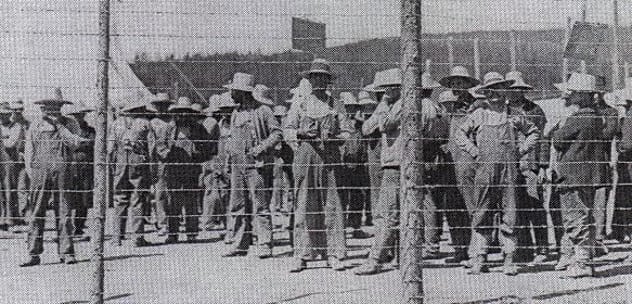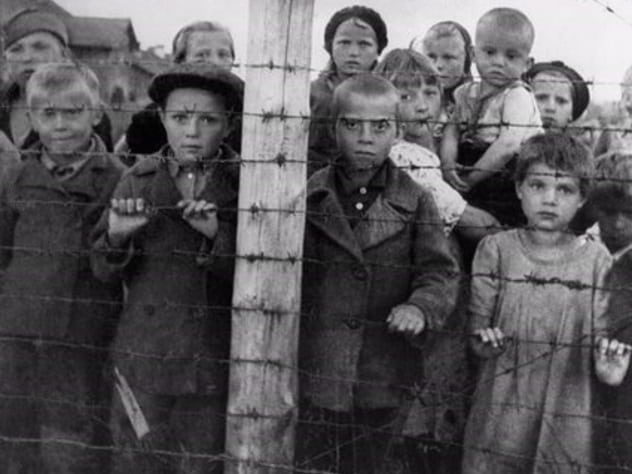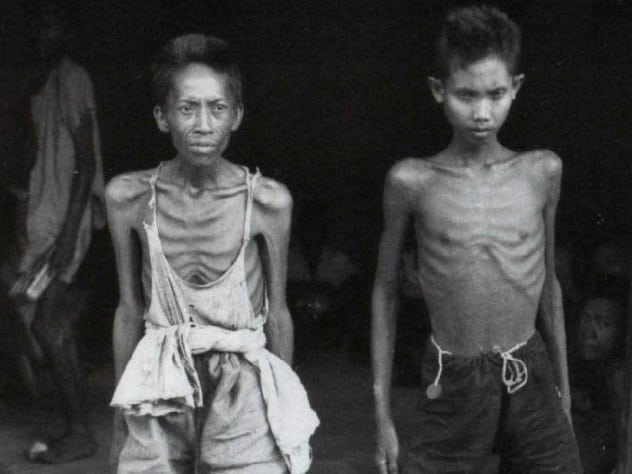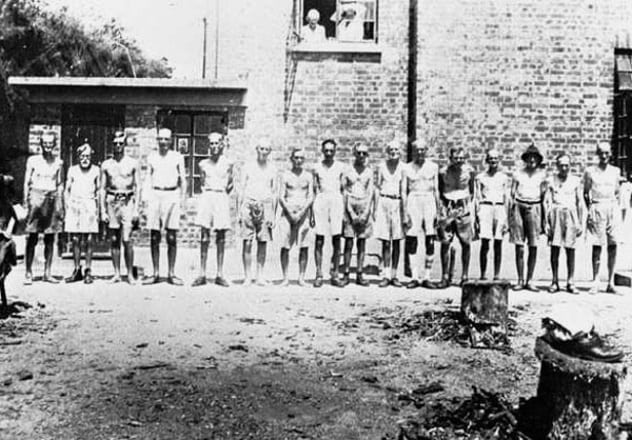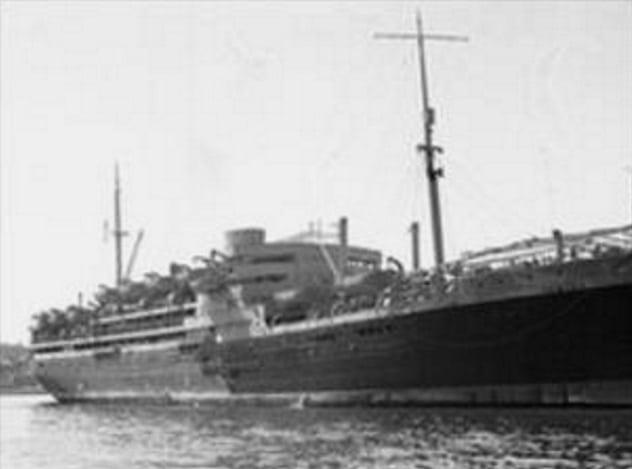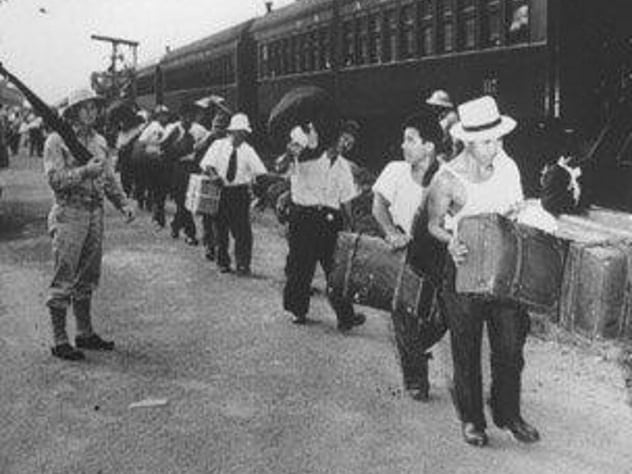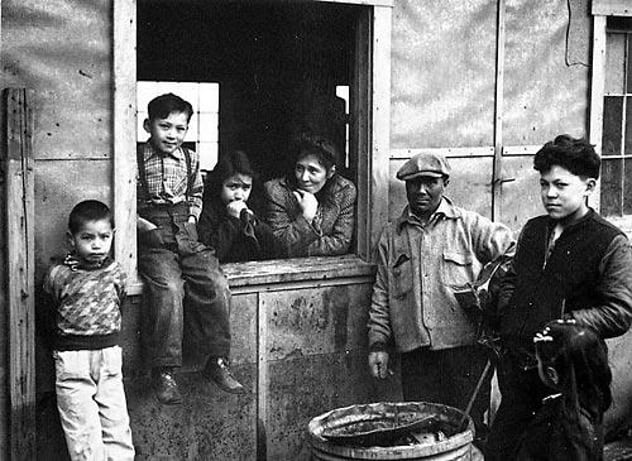This wasn’t something that just happened to Japanese people in the United States and Jews in Germany. Nearly every country that fought in the war locked up innocent civilians purely because of their ancestry. And some of the stories that don’t get told are even more horrifying than the ones you’ve heard.
10 Canadian Internment Camps Were Worse Than The American Ones
While Japanese Americans were being rounded up and forced into internment camps in the US, the exact same thing was happening north of the border. The 23,000 people of Japanese ancestry living in Canada were dragged off and locked up in camps that, in many ways, were even worse than the ones in the United States.[1] They were stripped of every possession they owned and told that their property would be held “in trust” until the end of the war. That, though, was an empty promise. Less than six months after they were locked away, all the property the government had taken from them was auctioned off without their consent. Many of the camps were converted barns and chicken coops that had been crudely insulated with tar paper. The prisoners weren’t given beds—instead, they were forced to sleep on straw-filled sacks that were often infested with fleas. The winter of 1942–1943 was one of the coldest ever recorded in British Columbia. Temperatures regularly dropped down below –40 degrees Celsius (–40°F). The internees had to shovel dirt and pack it against their thin walls just to keep from freezing to death. The United States started allowing their interned Japanese civilians to return to their homes in 1944, but the Canadians didn’t. They kept their Japanese prisoners locked up until April 1949 before finally sending them home. Even then, not everyone made it back. The government strongly encouraged their Japanese civilians they’d locked up to move to Japan and never come back. 4,000 of the interned Japanese were deported before a single one was set free.
9 The US Also Interned Italian, German, Taiwanese, And Korean Civilians
The Japanese weren’t the only people sent to internment camps in the United States. Under the order that sent the Japanese into the camps, Taiwanese and Korean civilians were considered Japanese. 11,500 German Americans and 2,700 Italian Americans (other sources claim between 1,900 and 10,000) were locked up for being immigrants from an enemy state, as well.[2] Compared to Japanese Americans, this was a fairly small portion of their population, but the ways they were chosen were often absurd. Joe DiMaggio’s father, for example, was very nearly sent off to the camps even though he’d lived in the US for more than 40 years, purely because he hadn’t yet applied for US citizenship. Hundreds of thousands more were put under strict restrictions. Over 600,000 Italian Americans who were spared from the camps were still put under a mandatory curfew, forbidding them to step outside of their homes between 8:00 PM and 6:00 AM. It all could have been a lot worse, though. A 1944 opinion poll showed that a good chunk of Americans supported turning the internment into an outright holocaust. A frightening 13 percent of the respondents said they were in favor of “killing off” every Japanese person in America—children included.
8 Jewish Refugees In Britain Were Interned And Deported
When Germany took Norway in 1940, paranoia started to consume Great Britain. Every person of German or Italian descent was labeled an “enemy alien” and locked up. Most of those people were Jewish. Of the 80,000 enemy aliens in Britain, 55,000 were refugees who had fled to Britain to escape persecution by the Nazis.[3] Those refugees were almost exclusively Jews—people who had barely escaped death in concentration camps, only to be locked in a different set of camps by the people who’d promised to protect them. Families were torn apart. The prisoners, for the first year of captivity, were separated into male and female camps, pulling husbands and wives apart and refusing to let them be together. An additional 7,000 were kicked out of the country altogether and sent off to camps in Canada and Australia. Not all of them survived the journey. One ship, en route to Canada, was attacked as a German vessel and destroyed. 714 people died.
7 Finland Starved 4,000 Prisoners To Death
In Finland, it was Russian civilians who were locked up in camps. When the Finnish army moved into East Karelia, they rounded up 24,000 Russian civilians who lived on the land and threw them into camps surrounded by barbed wire. The prisoners were barely fed, and before the war was over, 4,000 had died.[4] The families weren’t rounded up because they were any kind of threat; or, at the very least, that certainly wasn’t the main reason. They were meant to be bartering chips—Finland’s goal was to trade their civilian captives for prisoners of war. Others—the Jewish captives—could be used to win good faith with the Nazis. More than ten percent of the Jews in the camps were sent off to the Gestapo. Death, though, soon consumed the camps. Malnourishment was the greatest killer. Starving bodies fell throughout the camps, with the worst deaths hitting in the middle of 1942. Over just a few months, 3,500 Russian prisoners starved to death.
6 The Japanese Starved And Murdered Interned Civilians
The Japanese government locked up even more civilians than the Americans did. Throughout the war, they interned more than 130,000 enemy aliens living in the colonies that they’d invaded. These people weren’t soldiers—they were civilians living in Southeast Asian countries who just happened to be in the wrong place when the Japanese armies rolled in. In many places, though, the treatment was almost as bad as it was in the prisoner-of-war camps where they locked up enemy soldiers. In the most of the camps, the people were fed so little that they nearly starved to death, and violent force was used on anyone who stepped out of line. One internee said that beatings from Japanese guards were as “regular as the striking of the clock.” The worst camps, according to the survivors, were the ones with the fewest people. When there weren’t many witnesses around, Japanese guards would get brutal. The survivors of a camp in Nauru that only held seven prisoners said that, after an Allied bombing run, the guards beheaded two of the civilians in the camp just as a way to let off steam.[5]
5 Seven Prisoners In A Japanese Internment Camp Were Publicly Tortured And Executed
The largest Japanese-run internment camp was in Hong Kong. It was called the Stanley Internment Camp, and it held 2,800 civilian prisoners inside. Most of the people locked inside were British civilians who’d refused to flee Hong Kong when the Japanese armies rolled in. They were given nothing to eat but the scrapings of leftover food. A family of five would get little more than a bowl of rice and a bowl of stew to eat, and even that, according to an inmate, “frequently contained dust, mud, rat and cockroach excreta, cigarette ends and . . . dead rats.”[6] 121 of the internees didn’t make it out alive. The most horrifying story of all, though, happened to seven men who tried to stage an escape. They got their hands on a radio set and used it to contact the outside world—and when they were caught, the payback was horrible. The seven men were publicly tortured while the other inmates were forced to watch. When they couldn’t stand any more pain, the men were either shot or beheaded as a warning to the others never to try to escape.
4 Jewish Refugees Were Robbed And Beaten On The Way To Camps In Australia
Australia interned its Japanese, German, and Italian residents, as well. In total, they sent 7,000 of their own people into internment camps—but they took on another 8,000 from other countries, who were sent to be locked up inside their walls. The most horrifying story to come from their camps is that of the Dunera : a British ship that was used to send thousands of Jewish refugees to the prison camps in Australia. It was a vessel designed to fit only 1,600 people, but 2,500 were crammed on board.[7] 2,000 of those prisoners were Jewish refugees, some of whom had already seen the inside of the Nazi death camps and had fled to Britain hoping for salvation. Instead, they were locked up side by side with 451 genuine prisoners of war from Italy and Germany, putting them right next to the SS officers who had slaughtered their families. The prisoners had to sleep in piles on the floor and were only allowed 30 minutes of fresh air a day. For the entire journey, they were so tightly compacted that it was a struggle not to step on other people’s bodies. Showers were out the question, and the air was so filthy that prisoners would take turns pressing their faces against an open hatch in the wall. The whole trip took 57 days, and when it was done, they were thrown into prisons. When they got out of the boat, though, they found out that everything they’d brought with them was gone. The guards had gone through their luggage, taking everything that was worth money for themselves. The rest—like medicine and prayer books—were thrown into the sea.
3 Peru Deported Japanese Residents To American Internment Camps
2,200 of the Japanese prisoners in American internment camps had never lived in the United States before. They were from Peru: civilian prisoners rounded up, deported, and sent off to foreign camps, purely because their parents were Japanese.[8] The prisoners were sent at the request of the US government. US authorities wanted more civilian prisoners they could use as bargaining chips in negotiations with Japan. So, they got Peru to send them as many Japanese Peruvian civilians as they could. Peru was only too eager to oblige. The anti-Japanese sentiment there was vicious—in May 1940, a massive riot that broke out in the country ended with 600 Japanese-owned houses, schools, and businesses being burned to the ground. 800 of the civilians deported to the US wound up being sent to Japan in exchange for American prisoners of war. They were often separated from their families and forced to live in a place that, regardless of their ancestry, was a completely foreign country to them. Hardly any of them made it back home. When the war ended, Peru refused to allow the Japanese citizens they’d deported to step back into the country. Another 1,000 were shipped off to Japan after the war, while the luckiest few who were sent away were forced to make the United States their new homes.
2 Native Alaskans Were Interned And Died At Horrifying Rates
Not everyone in the internment camps was from an enemy country. 881 Native Americans living in Alaska were locked up for three and a half years, even though they were as American as anyone could possibly be.[9] The government didn’t suspect them of treason. Instead, they locked them up in the camps for what they said was their own safety. Alaska, they believed, was about to become a war zone, and so they moved them into camps—most of which were still right in the path of war. They didn’t protect anybody, though. The conditions were so horrible in these camps that the Native Alaskans died at a horrifying rate. Their camps were dilapidated, abandoned buildings; one was a converted gold mine, while another was an old cannery. Disease was rampant, with nearly every person in the camps infected. By the end of the three and a half years that the Alaskans spent in these camps, one in ten prisoners had died. Most went out in slow, painful deaths, starving, freezing, or plagued by disease.
1 Norway Labeled Its Own Citizens As ‘German Whores’ And Locked Them Up
When the war came to an end, some countries started focusing their wrath on their own citizens. In Norway, in 1945, 5,000 women were branded tyskertoes, meaning “German whores,” and locked up without trial inside internment camps.[10] Some of these women had taken German lovers while the Nazis occupied Norway, but many more hadn’t done anything of the sort. Women who had done any type of work for the Germans whatsoever were locked up, even if they’d just worked as cleaners or seamstresses. The government justified it as a way of protecting them—which wasn’t a totally unfair claim. Mobs would often drag these women out into the streets and shave off their hair, with newspapers and rallies cheering them on. That didn’t just happen in Norway. In France, women would be stripped, beaten, and paraded down the streets if anyone thought they’d supported the Germans in any way. More often than not, their heads would be shaved, and they’d have swastikas painted on their faces. The men, though, got off almost completely scot-free. In Norway, there were 28 men who had married German women during the war. They suffered no consequences at all—but every woman who had taken a German husband during World War II was deported from the country, deprived of her citizenship, and branded a traitor for life. Read More: Wordpress
